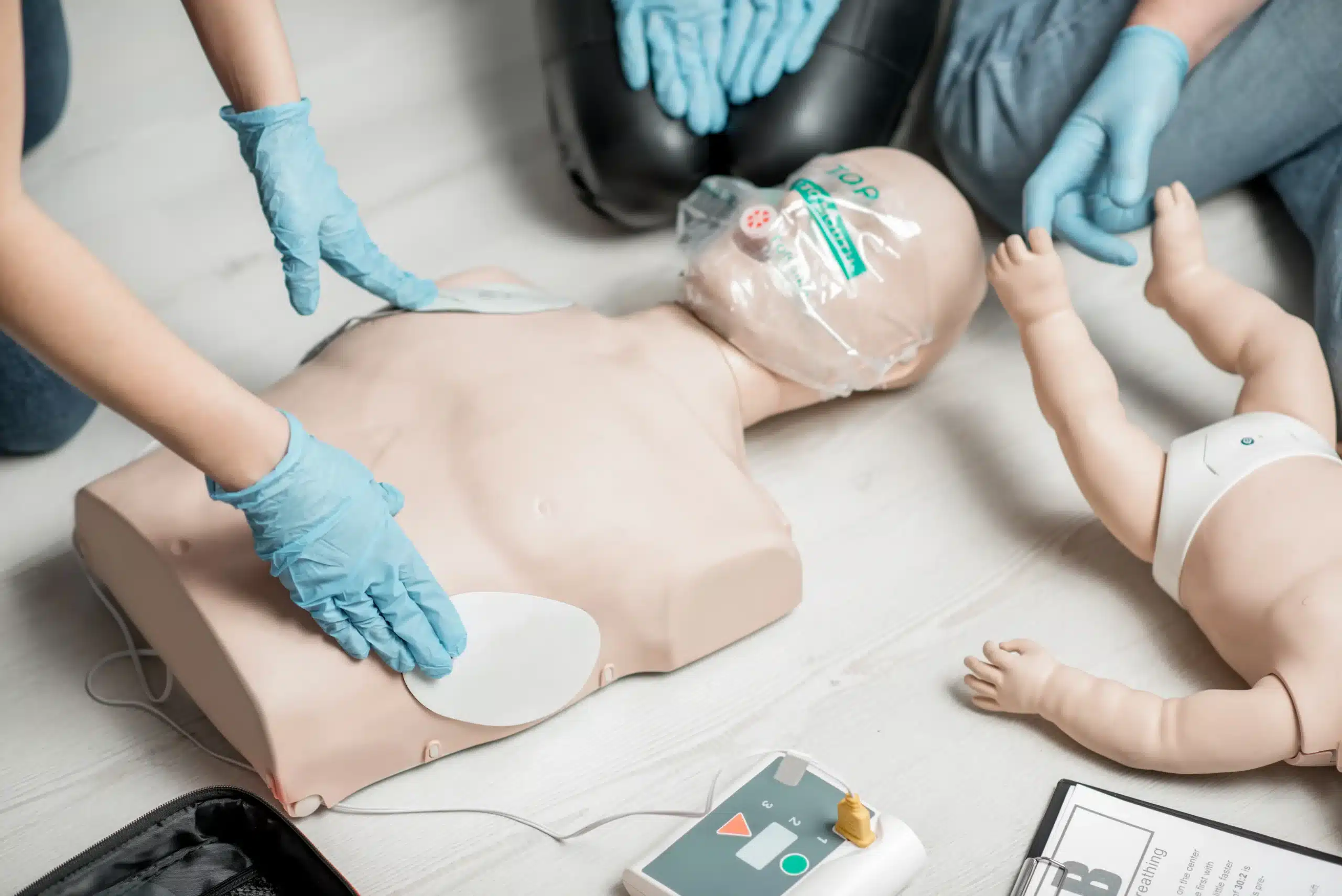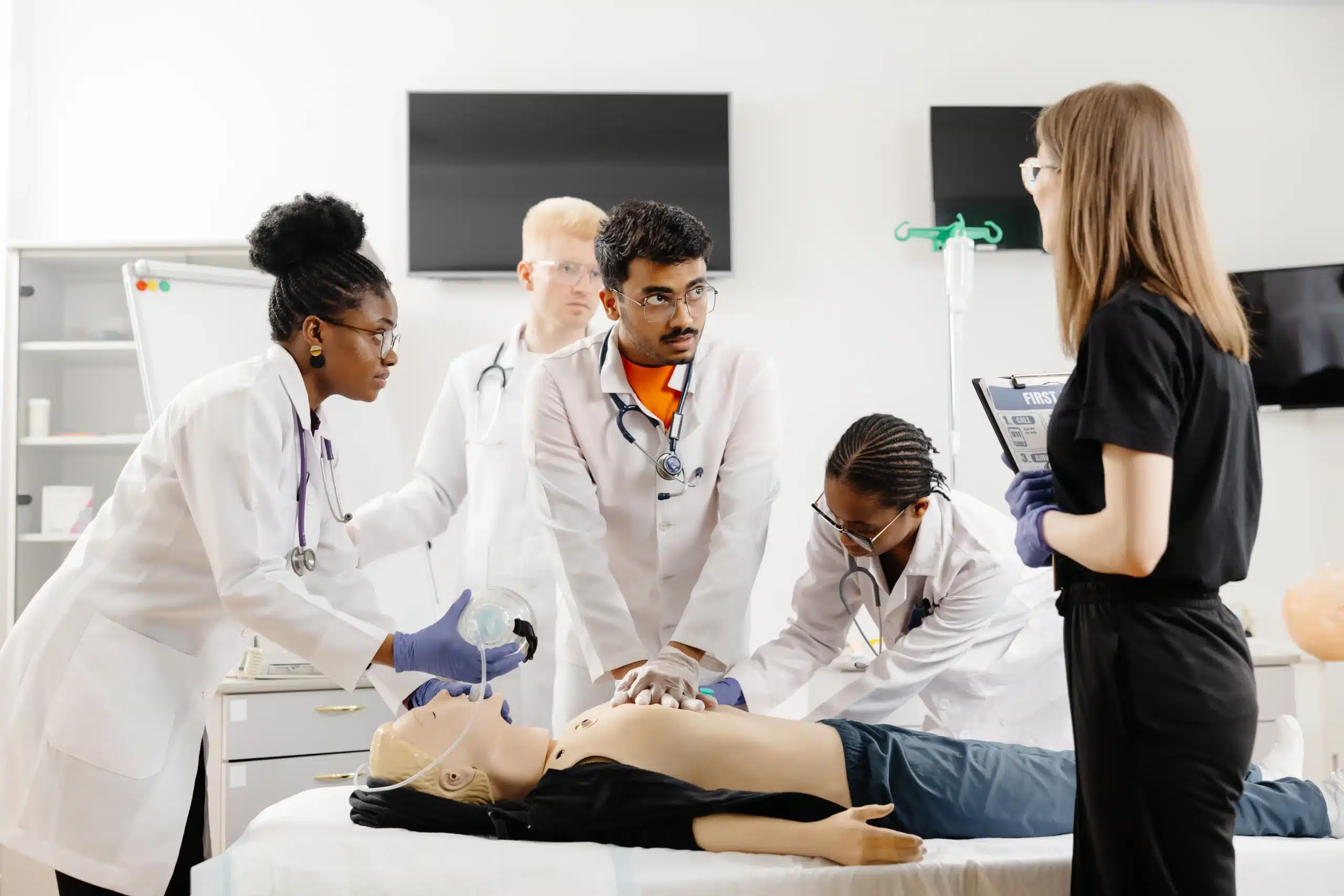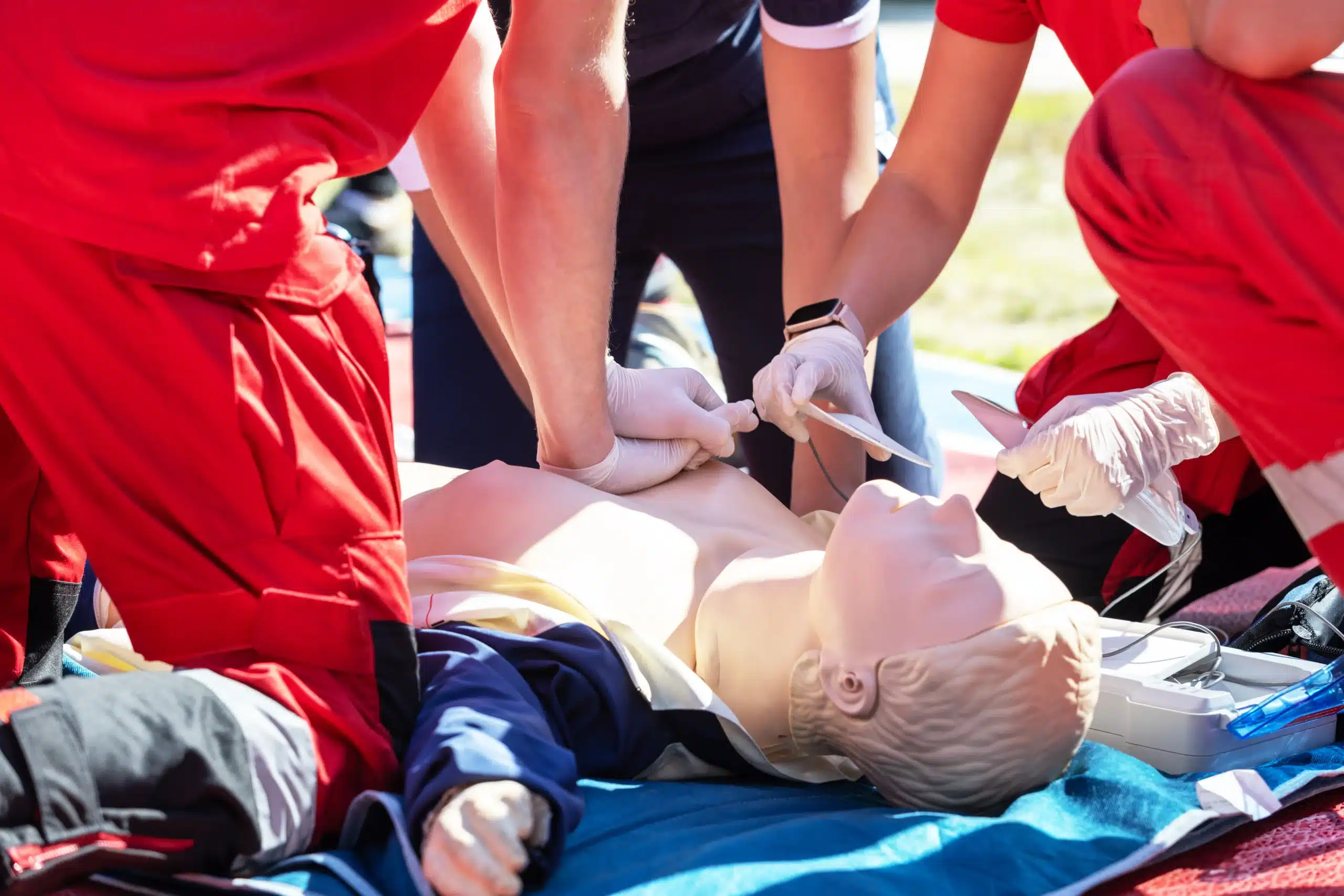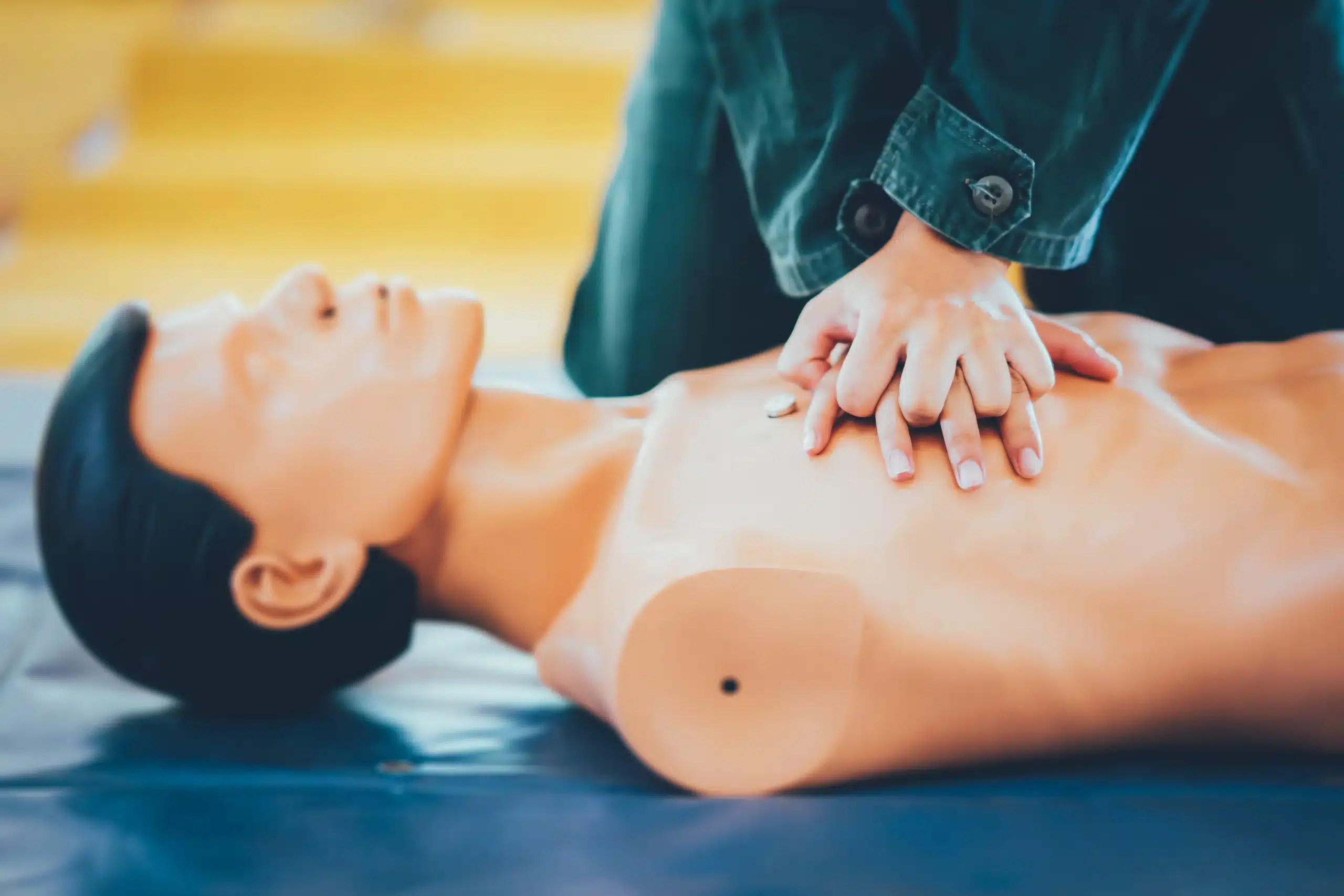Emergencies can happen anytime, anywhere. Are you ready to respond? CPR and first-aid training in Sacramento empowers you to act quickly and confidently in critical situations, potentially saving lives. Whether you’re a healthcare professional needing to maintain your certifications, a parent wanting to protect your family, or simply someone who wants to be prepared, this guide is for you. We’ll explore the different CPR and first-aid training options available in Sacramento, discuss the costs and benefits of certification, and address common misconceptions about these life-saving skills. Join us as we delve into the world of emergency preparedness and discover how Safety Training Seminars can help you become a more confident and capable responder.
Key Takeaways
- CPR and first aid training empowers you to help: These skills enable anyone to confidently respond to emergencies, potentially saving lives. Find a course that fits your needs and budget.
- Choose the training that works for you: In-person, online, or blended learning – select the format that best suits your schedule and learning style. Hands-on practice builds essential skills and confidence.
- Certification validates your skills: A recognized certification, such as those from the American Heart Association, demonstrates your competence and may be required for certain professions. Maintain your skills by staying current with recertification.
What is CPR and First Aid?
CPR (cardiopulmonary resuscitation) is a lifesaving technique used in emergencies when someone’s breathing or heartbeat has stopped. It involves chest compressions, and sometimes rescue breaths, to circulate oxygenated blood to the brain and other vital organs. CPR is critical in situations like cardiac arrest, where quick action can dramatically improve the chances of survival. Learn more about our CPR courses.
First aid involves the initial care you give to someone experiencing a sudden illness or injury. It covers a wide range of skills, from applying a bandage to handling more serious situations. The goal of first aid is to provide immediate support, prevent further harm, and aid recovery until professional medical help arrives. We offer comprehensive first aid training as well. Consider adding RQI training to your skillset.
CPR and first aid training together give you the confidence to respond effectively in emergencies. These skills are invaluable for everyone—check out our low price guarantee.
CPR and First Aid Training Options in Sacramento
Finding the right CPR and first aid training in Sacramento depends on your learning style, schedule, and certification needs. Let’s break down the different training options available: in-person, online, and blended learning.
In-Person Classes
In-person CPR and first aid classes offer hands-on learning, direct interaction with instructors, and real-time feedback. This format is ideal for those who learn best in a traditional classroom setting and value the opportunity to practice skills in a supervised environment. Safety Training Seminars offers in-person CPR classes certified by the American Heart Association, covering essential skills such as BLS, ACLS, and PALS. These courses provide comprehensive training and certification recognized by healthcare providers and employers. For additional in-person options, the American Red Cross also offers a range of CPR/AED and first aid classes in Sacramento.
Online Courses
Online CPR and first aid courses offer flexibility and convenience, allowing you to learn at your own pace and on your own schedule. This format can be a good starting point for those looking to familiarize themselves with the basics or renew existing certifications. However, it’s important to note that online-only CPR courses typically do not provide certification that complies with OSHA standards or other workplace requirements. The Red Cross offers online courses, but for certification purposes, they often require a supplemental in-person skills session. Check with your employer or regulatory body to ensure any online-only training meets their specific requirements.
Blended Learning
Blended learning combines the best of both worlds, offering the flexibility of online learning with the practical application of in-person skills sessions. You can complete the theoretical coursework online at your convenience and then attend a shorter in-person session to demonstrate your skills and receive personalized feedback. The Red Cross offers this blended learning approach for several of its CPR and first aid courses. For healthcare professionals seeking BLS, ACLS, and PALS certification, the American Heart Association’s RQI program is a blended learning option that combines online modules with in-person skills validation. This efficient and modern approach ensures you stay up-to-date with the latest resuscitation guidelines.
CPR and First Aid Class Costs
Knowing the price range for CPR and first aid training helps you budget and find the best value. Several factors influence the final cost, including the certification level, available discounts, and the training center you choose. Let’s break down these factors to give you a clearer picture.
Certification Level Pricing
Generally, more advanced certifications cost more. Basic CPR and first aid classes are usually the most affordable. Specialized courses, such as ACLS (Advanced Cardiovascular Life Support) or PALS (Pediatric Advanced Life Support), involve more comprehensive training and come at a higher price. These advanced certifications build upon basic CPR skills and cover more complex medical scenarios. Basic CPR and first aid are the foundation, while ACLS and PALS add specialized knowledge.
Safety Training Seminars’ Low Price Guarantee
At Safety Training Seminars, we believe everyone should have access to these life-saving skills. We’re committed to offering the lowest prices in Sacramento County, backed by our low-price guarantee. If you find a lower advertised price for the same course and certification, we’ll match it. This commitment to affordability helps ensure cost isn’t a barrier to learning these essential skills.
Discounts and Promotions
Many training centers, including Safety Training Seminars, offer discounts and promotions. These might include discounts for groups, students, or returning customers. Check for special offers, especially around peak seasons or holidays. Contact the training center directly to inquire about current promotions. You might be surprised at the savings. For example, Safety Training Seminars offers RQI classes (Resuscitation Quality Improvement) for healthcare professionals. Check our website for pricing details and discounts.
What Happens in a CPR and First Aid Class?
This section covers what you can expect during a CPR and First Aid class, from the moment you walk in to when you receive your certification. Understanding the process can help you feel prepared and confident.
Class Length and Format
CPR and First Aid classes are designed to fit various schedules and learning styles. In-person classes offer a focused learning environment and provide a two-year certification, meeting OSHA requirements. These hands-on sessions typically last a few hours. If you prefer learning at your own pace, online courses are a great option. For a combination approach, blended learning programs offer online coursework paired with in-person skills sessions. This allows you to study the material independently and then practice your skills with a certified instructor. Safety Training Seminars offers classes in Sacramento and surrounding areas, including both classroom and on-site options for groups.
Hands-On Practice
Hands-on practice is a crucial part of CPR and First Aid training. You’ll learn the essential skills needed to respond effectively in real-life emergencies. In these sessions, you’ll work with CPR training mannequins to practice chest compressions and rescue breaths. This tactile experience helps you understand the correct hand placement, depth of compressions, and the force required to perform CPR effectively. Instructors will guide you through various scenarios, providing feedback and ensuring you develop the muscle memory needed to perform these life-saving techniques. For First Aid training, you’ll learn how to manage common injuries like cuts, burns, and sprains. You’ll practice bandaging techniques and other essential first aid skills. Learn more about CPR training myths.
Course Materials and Equipment
During your CPR and First Aid class, you’ll be provided with all the necessary materials and equipment. This includes training manuals, videos, and anatomical charts to help you understand the concepts behind CPR and First Aid. You’ll also receive an official American Heart Association certification card, valid for two years, upon successful completion of the course. This nationally recognized certification demonstrates your competency in these vital skills. The hands-on practice sessions utilize realistic training mannequins, allowing you to experience the physical demands of performing CPR. This equipment helps you develop the confidence and skills needed to respond effectively in a real emergency. Safety Training Seminars offers AHA-compliant BLS courses with certification cards valid for two years. We also offer a low price guarantee, ensuring you receive high-quality training at an affordable price.
CPR and First Aid Certification: How Long is it Good For?
Knowing how long your certification is valid and how to renew it keeps you prepared for emergencies. This section covers everything you need to know about CPR and First Aid certification durations and renewals.
Certification Duration
CPR and First Aid certifications generally last for two years. This standard ensures you maintain up-to-date skills and knowledge in emergency response. After two years, skills can get rusty, and guidelines may be updated. This is why renewing your certification regularly is so important. Safety Training Seminars follows these guidelines, so your CPR certification through our program will be valid for two years.
Recertification Steps
Keeping your certification current is straightforward with readily available recertification courses. These classes offer a convenient way to refresh your skills and learn updates to CPR techniques and protocols. Recertification involves taking another class, similar to your initial certification, but often shorter as it focuses on a review of key skills and updates. Check with your certifying organization, like Safety Training Seminars, for specific recertification requirements and class schedules.
Stay Current
Staying current with your training is essential for providing effective help in emergencies. It’s important to understand the differences between certifications like BLS (Basic Life Support), designed for healthcare professionals, and CPR/AED certification for the general public. These distinctions highlight the importance of training tailored to your role. For AHA certifications like BLS, hands-on, in-person training is often the best way to learn and retain these critical skills. This type of training provides real-time feedback and practice, leading to better skill mastery and confidence in emergencies.
Who Should Get CPR and First Aid Certified?
Knowing CPR and first aid can make a real difference in an emergency. While valuable for anyone, certain professions and individuals benefit significantly from certification.
Healthcare Professionals
For healthcare providers like doctors, nurses, and EMTs, CPR and first-aid certification is often a job requirement. These skills are crucial for responding to medical emergencies and providing immediate care. Regular training ensures these professionals stay up-to-date with the latest guidelines and maintain their life-saving skills. You can find more information on our BLS page. We also offer ACLS training for advanced cardiac life support.
Childcare Providers
Anyone working with children, including daycare providers, teachers, and camp counselors, should be equipped to handle medical emergencies. CPR and first-aid training designed for children is essential. Knowing how to respond to choking, allergic reactions, and other common childhood injuries creates a safer environment. Our EMSA Child Care Health & Safety course covers important preventive health and safety practices.
General Public and Industries
Even if it’s not required for your job, CPR and first-aid certification is a valuable asset. From parents and grandparents to construction workers and personal trainers, knowing these skills helps you respond confidently in unexpected situations. Think of it as a personal safety net, not just for yourself but for those around you. Check out our RQI classes for another way to stay prepared. With our low price guarantee, getting certified is more accessible than ever.
Where to Get CPR and First Aid Training in Sacramento
Finding the right CPR and first aid training program is crucial for effective emergency preparedness. Here are a few options to consider in the Sacramento area:
Safety Training Seminars
Safety Training Seminars, a woman-owned American Heart Association (AHA) Training Center, offers various certification courses. They provide training in CPR, BLS, ACLS, PALS, and first aid, with a focus on affordability. Check out their low price guarantee. Safety Training Seminars serves Sacramento, Roseville, and Rocklin, CA. They also offer EMSA Child Care Health & Safety training and RQI classes.
American Red Cross
The American Red Cross is a well-known provider of CPR and first aid training in Sacramento. They offer various learning formats, including in-person classes, online courses, and blended learning options. Their in-person training provides a two-year certification meeting OSHA requirements.
CPR Certification Sacramento
CPR Certification Sacramento specializes in AHA-certified CPR and first aid classes. They emphasize same-day certification cards and their experience training over 100,000 students nationwide.
Sacramento State University
While Sacramento State University may offer CPR and first aid training, details about specific programs weren’t readily available. Checking the university’s website or contacting their health services department directly might provide more information.
Find the Right CPR and First Aid Course
Finding the right CPR and First Aid course depends on your specific needs and goals. Let’s break down a few popular options and considerations to help you choose the best fit for you.
American Heart Association (AHA) Certifications
If you’re looking for widely recognized and respected certifications, the American Heart Association (AHA) offers several key courses. These include Basic Life Support (BLS), Advanced Cardiovascular Life Support (ACLS), and Pediatric Advanced Life Support (PALS). AHA certifications are often preferred by healthcare providers and those seeking comprehensive training. As a woman-owned AHA Training Center, Safety Training Seminars provides official AHA certification cards upon completion of their training.
EMSA Childcare Health & Safety Training
For those working with children, the Emergency Medical Services Authority (EMSA) provides specialized training in childcare health and safety. This training covers essential procedures and best practices for handling emergencies in childcare settings. It’s a valuable resource for daycare providers, nannies, and anyone responsible for the well-being of children. In addition to EMSA training, the AHA’s Resuscitation Quality Improvement (RQI) program offers a flexible and convenient way for healthcare professionals to maintain their CPR skills and certification.
Compare Training Options
Before committing to a course, take some time to compare different training options in Sacramento. Consider factors like cost, class format (in-person or online), and the specific skills covered. Look for a program that aligns with your schedule, budget, and learning style. Safety Training Seminars offers a low price guarantee for their courses, making them an affordable option for high-quality training. Don’t hesitate to contact various training providers to discuss your needs and ask questions before making your decision.
CPR and First Aid Myths
Let’s clear up some common misconceptions about CPR and first aid. These myths can prevent people from seeking training and being prepared to help in a crisis.
“Only Medical Professionals Can Perform CPR”
One of the biggest myths is that only doctors and nurses can perform CPR. This isn’t true. Anyone can learn CPR, and, in fact, it’s encouraged! Bystander CPR can dramatically increase someone’s chances of survival after cardiac arrest. Learning basic CPR can empower you to make a real difference in an emergency.
“CPR Training Takes Too Long and Costs Too Much”
Worried about fitting CPR training into your busy schedule or breaking the bank? There are plenty of flexible and affordable options available. Safety Training Seminars offers a variety of courses to fit different needs and budgets. The time and money you invest in a CPR class is a small price to pay for the ability to potentially save a life. Check out our low price guarantee.
“You Can Get Sued for Performing CPR”
Many people hesitate to help in an emergency because they fear legal action. Good Samaritan laws generally protect those who offer assistance during a medical crisis, provided they act reasonably and within the scope of their training. These laws encourage people to step up and help without worrying about being sued. Focus on getting the training you need to feel confident acting in an emergency.
Why Get CPR and First Aid Certified?
Knowing CPR and first aid can make a real difference in critical situations. It empowers you to take action and potentially save a life. From job opportunities to personal preparedness, there are several compelling reasons to become certified.
Save Lives
CPR and first-aid training equips you with the skills to respond effectively in emergencies. Learning CPR can be invaluable during those crucial moments when every second counts. You could be the one who helps someone during a medical crisis, bridging the gap until professional medical help arrives. This knowledge can truly be the difference between life and death.
Improve Job Prospects
A CPR and first-aid certification can significantly enhance your resume and open up new career opportunities. Many professions, especially in healthcare, education, and childcare, require or prefer candidates with these certifications. Displaying these credentials demonstrates your commitment to safety and preparedness, making you a more competitive applicant. Even if it’s not a job requirement, it shows initiative and a willingness to go the extra mile.
Prepare for Emergencies
Life is unpredictable, and emergencies can happen anytime, anywhere. Being prepared for such situations can bring peace of mind. CPR and first-aid certification provides you with the practical skills and confidence to handle unexpected medical situations, whether at home, work, or out in the community. Getting certified isn’t overly time-consuming or expensive, and the benefits far outweigh any perceived inconvenience. The hands-on training you’ll receive in a class, using mannequins and other equipment, ensures you’re truly ready to respond effectively in a real-life emergency. Check out our low price guarantee to see how affordable training can be.
Related Articles
- CPR Courses in Roseville: Your Complete Guide – Sacramento CPR Classes
- CPR Classes in Sacramento: The Complete Guide – Sacramento CPR Classes
- First Aid Training in Roseville: A Complete Guide – Sacramento CPR Classes
- CPR Certification in Sacramento: Your Guide – Sacramento CPR Classes
- First Aid Training Sacramento: A Comprehensive Guide – Sacramento CPR Classes
Frequently Asked Questions
How much do CPR and first aid classes typically cost?
The cost of these classes varies depending on the level of certification, the training provider, and any available discounts. Basic CPR and first aid classes are generally the most affordable, while more specialized certifications like ACLS and PALS cost more. It’s always a good idea to check with the training center for current pricing and any special offers they might be running. Safety Training Seminars offers a low price guarantee, ensuring competitive pricing for their courses.
What’s the difference between online and in-person CPR training?
Online CPR training offers flexibility and convenience, allowing you to learn at your own pace. However, online-only courses typically don’t provide certification that meets workplace requirements. In-person classes provide hands-on learning, direct interaction with instructors, and the opportunity to practice skills in a supervised environment. In-person training often leads to certification recognized by employers and regulatory bodies.
How long is CPR and first aid certification valid?
CPR and first aid certifications are typically valid for two years. Renewing your certification is essential to stay up-to-date with the latest guidelines and maintain your skills. Recertification courses are readily available and offer a streamlined way to refresh your knowledge and skills.
Who needs CPR and first aid certification?
While valuable for anyone, CPR and first aid certification is especially important for healthcare professionals, childcare providers, and those in roles requiring emergency preparedness. Even if not required for your job, having these skills can be a valuable asset in any situation. It empowers you to assist family, friends, and community members in times of need.
What can I expect during a CPR and first aid class?
Expect a combination of instruction and hands-on practice. You’ll learn the fundamentals of CPR and first aid, practice techniques on mannequins, and receive guidance from certified instructors. The class will cover essential skills like chest compressions, rescue breaths, and how to respond to various medical emergencies. You’ll receive all the necessary materials and equipment during the class, and upon successful completion, you’ll receive an official certification card.








